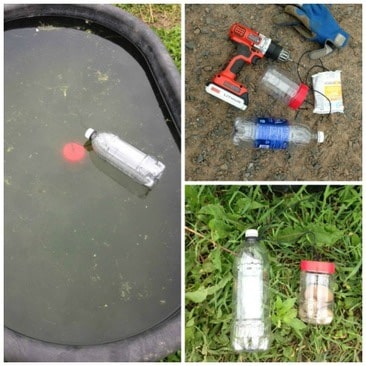One of my recent projects is a science experiment of sorts. I created a chlorine floater for the livestock tanks that are out on pasture. When it gets hot out the water in the tank can start to build up algae. With our recent rains and hot weather, the water in our stock tank was starting to show a little green.

To solve this problem water can be changed out, but that’s not realistic and can be wasteful if done daily. Many livestock farmers use different techniques to keep the water clean for their animals, making it more appealing and healthier to drink. Usually the practices are similar in nature to treated water that that people drink from municipal (city) water sources.
One technique is to create a chlorine floater. I learned about the simple device during Meg Grzeskiewicz’s (Rinestone Cattle Co.) presentation at the GrassWorks Grazing Conference last January. Here’s an article Meg wrote about easy grazing tips, including this floater.
My supplies: peanut butter container with holes drilled into it, water bottle, rope, small rocks and small chunk of a pool chlorine tab. The two plastic containers are tied together with the rope. The PB container holds the chlorine tab and rocks to weigh it down, while the water bottle serves as a float to keep the PB container in place (and easy to pull out of the tank). I’ll keep adding chlorine to the PB jar as it runs out. She could see improvements to the water after three days of use. And, animals started drinking more water because it was cleaner.
Meg’s instructions were based on large, cattle tanks. We use smaller tanks that are lower to the ground for easy access for both small and large goats. So here’s where my science experiment comes into play. I’m starting with a very small piece of chlorine tab to see how much chlorine that’s needed to keep the water clean. I’ll be monitoring the tank daily, observing the water quality and amount of chlorine still in the floater. After sometime, I’m hoping I find the right amount of chlorine to use based on our water tank size.
My other challenge may be keeping both the dogs and goats from playing with the floater. If they do, I’ll just have to make some adjustments to the string to pull the top floater down. Since our tanks are fairly short, I may just drop the PB jar in without a floater.
LEAVE A COMMENT
Comments